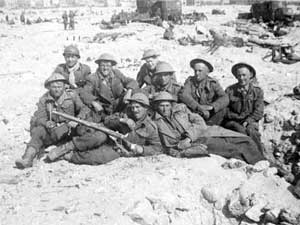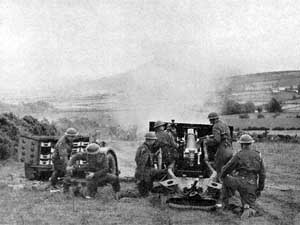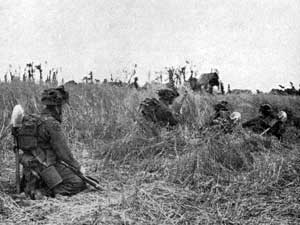Organization
- Reconnaissance
59th reconnaissance regiment - 176th infantry brigade
7th Norfolk regiment
7th South Staffordshire regiment
5th South Staffordshire regiment - 177th infantry brigade
5th South Staffordshire regiment
1/6th South Staffordshire regiment
2/6th South Staffordshire regiment - 197th infantry brigade
1/7th Royal Warwickshire regiment
2/5th Lancashire Fusiliers regiment
5th East Lancashire regiment - Support
Royal Northumberland Fusiliers - Artillery
61st field artillery regiment
110th field artillery regiment
116th field artillery regiment
68th anti-tank regiment
68th light anti-aircraft regiment
History
A “duplicated” division
In the summer 1939, it became obvious that a new war was going to take place. Anticipating the forcoming crisis, the British army needed to reinforce its army by creating new divisions. For that, it had recourse to duplication: this approach consisted in taking from an existing division a core of experienced officers to form the structures of a new division.
It was decided that the 55th West Lancashire division would form the 59th Staffordshire infantry division on this basis. On August 21st, this latter was reactivated, endorsing the tradition of the homonymous unit which had fought during the Great War.

59th ID spent the following months on training. Its 1/7th Royal Warwickshire and 1/6th South Staffordshire battalions were attached to the British Expeditionnary Force, and fought on the continent, before having to re-embark in Dunkirk in June. Gathered again, the different elements of division were garisoned for the four following years in Ireland, then in Kent. In July 1943, division was attached to the 12th Corps (with 43rd Wessex and 53rd Welsh infantry divisions) and it was decided that the Staffordshire division would take part in the struggle on the continent.
Engagements in Normandy

The first elements of Staffordshire began to land in Normandy on June 26th. As of July 7th, division took part to operation Charnwood , directed aginst Caen. Attached to the 1st Corps, it launched its attack southward, between the 3rd British and Canadian ID. Its first struggle occured very difficult, some companies which attacked in direction of Bijude loosing all their officers…. It is only in the evening that it managed to occupy Galmanche, but its effort, by attracting german attention, allowed the other divisions to close on their targets.
Between July 16th and on 18th, division was attached to the 30th Corps to take part in operation Pomegrenate . It was a diversion operation on the right flank of Goodwood, intended to divert German attention. Starting its attack from the battlefield of the previous operation Epsom (Rauray, Cristot, Fontenay Pesnel), it tried to push in direction of the south. July 17th, the 177th brigade reached Noyers, but had to be withdrawn because of the strong enemy counter-attack. Finally, the 176th brigade captured Senevière, and the operations were suspended the following day, division being limited then on this sector to offensive patrols. For a short step forward, losses were almost as important as at the time of fighting north of Caen…
From August 6th, Staffordshire division was engaged in the struggle for Villers-Bocage. Attached this time to the 12th Corps, 59th ID established a bridgehead in Grimbosq the next morning. Tigers from kampfgruppe Wunsche, gathered in the evening, launched a strong assault which forced most of 7th South Staffordshire to recross the river, but a massive artillery barrage allowed the division to save the bridgehead. Reinforced by the 56th brigade, 59th ID pushed back the German 271st ID on Thury-Harcourt, but it still had to launch several unsuccessfull attacks before managing to have Germans leave the city on the 14th. The last fight delivered by the 59th ID was to push back the forces of the 7th German Army in the Falaise pocket. Hot on Germans heels, the Staffordshires moved full east, in direction of Commeaux and the RN 158 which it reached the 18th.

In spite of many evidence of its combativeness, the war path of 59th ID was to stop there. Because of the losses suffered by the 2nd Army since the beginning of the battle of Normandy, the British high command decided to dissolve some units to reallocate their manpower to other divisions. The 59th, being one of youngest, suffered this fate. As of on August 23th, the battle of the Falaise pocket just finished, it headed for Great Britain.
It remains with its soldiers the pride to have fought within the only unit “duplicated” committed out of British Isles.










